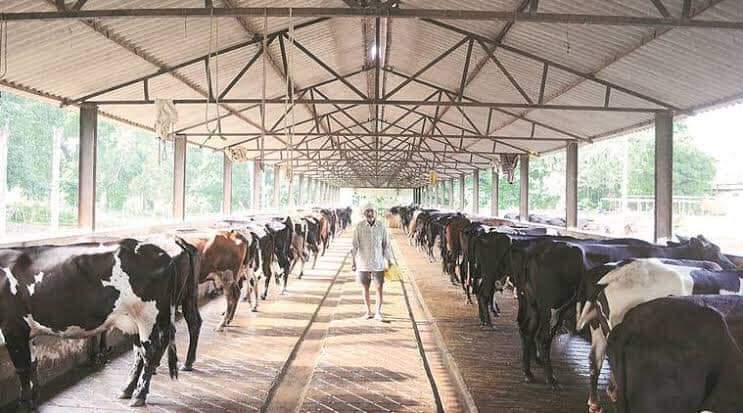Homoeopathic Approach to treat Bovine Clinical Mastitis
Post no 1369 Dt 24th August 2019
Compiled & shared by- DR RAJESH KUMAR SINGH, JAMSHEDPUR,9431309542,rajeshsinghvet@gmail.com.
Mastitis is a disease that affects a large number of dairy cattle throughout the world.Using antibiotics is not an ideal solution. Other than the problems they cause with the milk (withdrawal for x days, contamination from antibiotic residues, problems associated with yogurt and cheese processing), antibiotics have not reduced the incidence of mastitis. Problems associated with resistance or even ineffectiveness are quite real in the case of mastitis caused by coliforms and Staphylococcus aureus.
TYPES OF MASTITIS
Since mastitis is a disease that has different levels of intensity and may be caused by different organisms, there exists a complete lexicon to describe the disease. Indeed, there are a number of types. It is therefore important to be able to recognize the different types of mastitis in order to decide what preventive measures or treatments to use.
Table 1 – Characteristics of the different types of mastitis
Types of Mastitis Characteristic Symptoms or Definition
Acute clinical Inflammation of the teat, fever above 39C, weak and dejected animal, lack of appetite. Drastic drop in milk yield. Often follows calving and, less seriously, after cow goes dry.
Hyperacute clinical Swollen, red, painful quarter. Milk passes with difficulty. Fever over 41C. Cow has no appetite, shivers and loses weight quickly. Lactation often stops.
Subacute clinical No apparent change in udder, presence of flaky particles in milk, especially in initial ejection. Subject appears healthy.
Subclinical No symptoms. 15 to 40 cases for every clinical case. Milk appears normal. Only change is detection of pathogenic agent in analysis and increased somatic cell count. Mostly caused by Staphylococcus aureus.
Chronic Repeated but mild clinical attacks, generally without fever. Lumpy milk, quarters sometimes swollen. Quarter may become hard (fibrous indurations). Antibiotic treatments often do not work.
Gangrenous Affected quarter is blue and cold to the touch. Progressive discolouration from the tip to the top. Necrotic parts drop off. Cow often dies.
Contagious Mastitis caused by bacteria such as Staphylococcus aureus and Streptococcus agalactiae, of which other infected cows are the main source.
Environmental Mastitis caused by bacteria such as coliforms (e.g. E. coli), of which the main source is a contaminated environment, i.e. manure.
Bovine clinical mastitis is a disease of paramount importance in female milch breeds. If not given attention at proper time then not only it dampens the milk production but also significantly affects the economy of the herd. Most of the cases even after the treatment the animal seldom attains its full productivity. The condition is also worsened by the reduction in the size of the teat and the udder. If any contaminants or debris get accessed inside the udder then there is every possible chance of spreading the infection to the other healthy compartments of the udder. In female it sometimes affects other reproductive parts (Metritis-Mastitis Complex). The prognosis in such cases are always grave. The medicinal approach (Allopathic approach) to treat such anomaly is very costly and effective only to some extent but the quality and taste of the milk cannot be restored. In certain cases purulent discharge comes out from the udder which if not treated properly then toxaemia prevails and animal gradually succumbs to death. However homeopathic treatment being cost effective and has no side effects on animal health, now gaining momentum in animal practices. Hence the farmer should consider the use of homeopathic drugs given below to treat clinical mastitis with following symptoms
• If the udder is swollen and hard and watery or curdled milk comes out from it
Cal Sulph – 6×
Hyper Sulphur – 6×
Cal player – 1M
Phytollyca – 1M
Belladona – 1M
Administer three to four times orally daily
• If the udder and teat became cyanotic (Blue colour)
Arsenicalbs – 200
Lychasis – 200
Agnus cast – 200
Administer 20 drops each, three to four times orally daily
• If blood comes along with milk but there is no inflammation or swelling of the udder
Arnica – 1M
Hypericum – 1M
Administer three to four times orally daily
• If milk present in the udder but flow of milk from the teat is less
Conium Mac- 1M
Administer three to four times orally daily
• If there is change in the shape of the teats
Phytollyca – 1M
Pulsetilla – 1M
Administer three to four times orally daily


